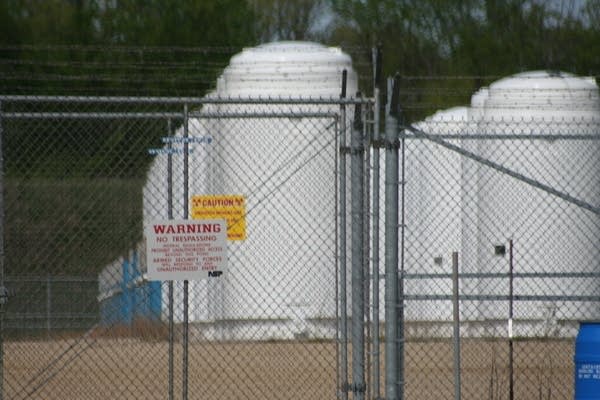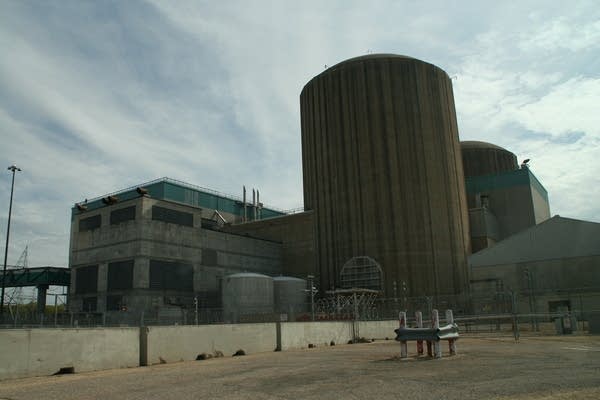PUC approves Prairie Island power increase

The Minnesota Public Utilities Commission has approved a plan for Xcel Energy to increase the power it produces at its Prairie Island nuclear plant, and to store more radioactive waste on site.
The PUC approval came Thursday afternoon with a couple of conditions. The PUC wants Xcel to study impacts of the plant on ice formation on Lake Pepin, and to help the city of Red Wing with emergency response expenses.
The mayor of Red Wing, John Howe, is critical of the PUC's decision. He said he's not opposed to nuclear power, but there's no plan for dealing with the waste.
"What we're doing here today is putting the burden on our children's grandchildren. We're just not facing the reality of what's happening," said Howe.
Create a More Connected Minnesota
MPR News is your trusted resource for the news you need. With your support, MPR News brings accessible, courageous journalism and authentic conversation to everyone - free of paywalls and barriers. Your gift makes a difference.
Nuclear power plants all over the country are boosting their power, a step called an uprate. They change their equipment to produce more heat and steam, to produce more electricity.
Xcel Energy has said it will spend $600 million to refurbish the Prairie Island plant so the equipment can handle the higher temperatures and pressures that will come with adding 164 megawatts to its output.

Currently, Prairie Island puts out more than 1,000 megawatts, enough to power about one-fifth of Xcel's customers. This project will add 15 percent to that capacity.
Xcel's director of regulatory administration, Jim Alders, said the investment is cheap, compared to producing the power any other way.
"We have a unique situation, a great opportunity here to keep our overall cost of energy low and our environmental performance high," Alders said.
State law requires utilities to prove their plans are the most cost-effective way to generate power. Alders said Xcel studied wind energy combined with natural gas, hydro power from Canada, and small-scale renewable technologies. All were found to be more expensive than boosting power at Prairie Island.
But critics say Xcel is not paying enough attention to the cost of dealing with nuclear waste.
"We think it's in the public interest to move to more renewable energy, perhaps right now backed up with natural gas, rather than continuing to rely on, and expand our reliance on nuclear power, which has unsolvable waste problems," said Attorney Paula Maccabee, who represents the Prairie Island Study Group.
"What we're doing here today is putting the burden on our children's grandchildren. We're just not facing the reality of what's happening."
The federal government promised to build a permanent repository for nuclear waste, but that hasn't happened. President Obama said a planned repository at Yucca Mountain in Nevada will not work, so nuclear plants around the country are storing their waste on site.
At Prairie Island, that means eventually there would be 98 casks on a concrete pad next to the plant, on an island in the Mississippi River -- the source of drinking water for many communities downstream.
The plant's nearest neighbors live about four blocks away, and many members of the Prairie Island Indian Community say they're nervous about possible health effects.
Monitors around the spent-fuel casks and the plant itself show very small amounts of radioactive contamination in the air, and in wells nearby. State and federal officials say the radioactivity is barely higher than the levels that normally are found in any water, soil or air.
But tribal attorney Philip Mahowald does not trust the current monitoring. He said it's inadequate, and he said with all the money Xcel plans to spend on the expansion, they should invest in a better system.
"When we asked how much of their uprate budget was going to be spent on enhancing and improving environmental monitoring, they said nothing," Mahowald said. "That just seems wrong."
The added power is expected to increase radioactive discharges to the air and to the Mississippi River by about 10 percent. That's still far below established standards for human exposure, according to state and federal rules. But scientists say even the smallest dose of radiation has the potential to cause a small increase in risk.
Xcel also needs to renew its operating license with the federal Nuclear Regulatory Commission. Its current license expires in 2014.
Xcel's Jim Alders said that renewal process will not include a detailed health risk assessment, because the federal agency looked at health risks in an environmental review that it did for all nuclear plants wanting to renew their licenses.
In addition to the operating license renewal, there is a process for the NRC to approve the power boost.
Some nuclear plants around the country have experienced problems when they increased power. In some plants, vibrations led to cracked pipes and severe corrosion. But Xcel said it is learning from the problems and can avoid them.
The Minnesota Public Utilities Commission has already approved increasing power at Xcel's other nuclear plant, at Monticello. The company expects approval from the federal government.
Even though the PUC has approved Xcel's plans for the Prairie Island plant, the approval will be put on hold until the end of the coming legislative session. In Minnesota, the final say on nuclear storage at Prairie Island rests with legislators.
